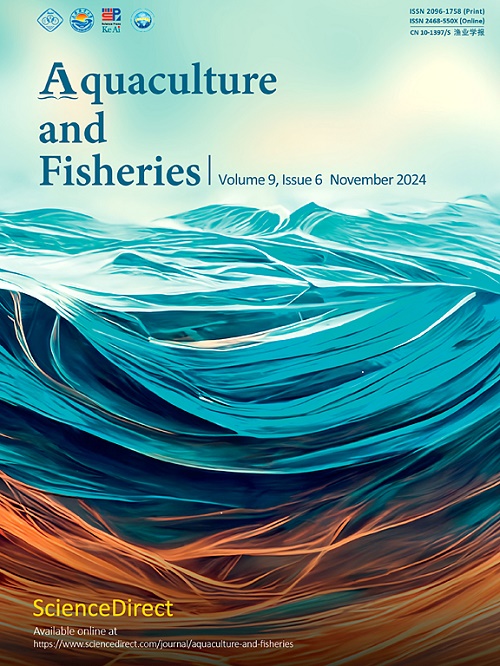从孟加拉国南部不同沿海生境采集的天堂线鱼(Polynemus paradiseus)的体形差异:种群鉴别的多元方法
Q1 Agricultural and Biological Sciences
引用次数: 0
摘要
天堂线鱼(Polynemus paradiseus)是一种重要的商业和生态的全盐鱼类,主要生活在多样化的沿海和河口栖息地。全面了解体型的差异和与生境有关的种群参数的差别对渔业管理和养护工作至关重要。为了检验不同沿海环境下的天顶小蠊种群之间是否存在显著的形态差异,在东南沿海地区的Cox's Bazar (Bakkhali河)和Chattogram (Karnaphuli河),中南部地区的Noakhali (Meghna河下游),五个遥远的地方共采集了366只(雄性198只,雌性168只)。2022年11月,孟加拉国孟加拉湾附近西南地区的库尔纳河(Shibsa河)和博古纳河(Borguna河)。桁架网络和几何形态计量学分析(GMA)表明,雌雄二态性导致了天南星个体的体型差异。线框图显示,雌性个体的背腹部分比雄性更宽。使用五个沿海栖息地的桁架网络数据集,多变量分析揭示了两个重叠的集群:西南(Borguna和Khulna)种群在一个集群中,而中部(Noakhali)和东南部(Chattogram和Cox's Bazar)种群形成单独的集群。GMA还表明,Khulna-Borguna种群位于Chattogram-Cox's Bazar种群轴的另一端附近,Noakhali种群位于中间,重叠程度较高。线框图显示了种群间体型的显著差异,主要表现在嘴形、背腹部宽度、尾形和头形。判别函数分析表明,距离较远的两个种群的体型差异较大,距离较近的两个种群的体型差异较小。这项研究强调了基于地标的桁架网络和几何形态计量学在识别不同栖息地的形态变化方面的有效性。这些变化可能具有适应意义,对大白杨种群结构的知情种群管理和保护策略至关重要。本文章由计算机程序翻译,如有差异,请以英文原文为准。
Body shape divergence of paradise thread fish (Polynemus paradiseus) collected from different coastal habitats of southern Bangladesh: A multivariate approach for population discrimination
The paradise thread fish (Polynemus paradiseus) is a commercially and ecologically important euryhaline fish that primarily lives in diversified coastal and estuarine habitats. A comprehensive understanding of the divergence in body shape and discrimination in population parameters related to habitats is crucial for fisheries management and conservation endeavours. To test whether significant morphological differences exist between P. paradiseus populations inhabiting different coastal environments, a total of 366 individuals (198 male and 168 female) were collected from five distant places over three zones- Cox's Bazar (Bakkhali River) and Chattogram (Karnaphuli River) in the southeast coastal regions, Noakhali (lower Meghna River) in the southcentral zone, and Khulna (Shibsa River) and Borguna (Bishkhali River) in the southwest zones adjacent to the Bay of Bengal, Bangladesh in November 2022. The truss networking and geometric morphometric analysis (GMA) indicated variations in body shape among P. paradiseus individuals induced by sexual dimorphism. Wireframe graphs demonstrated that female individuals had wider dorsal-abdominal parts than males. Using the truss networking dataset for five coastal habitats, multivariate analyses revealed two overlapping clusters: southwest (Borguna and Khulna) populations in one cluster, while central (Noakhali) and southeast (Chattogram and Cox's Bazar) populations form separate clusters. The GMA also illustrated that the Khulna-Borguna population was located near the opposite end of the Chattogram-Cox's Bazar population axis, and the Noakhali populations were somewhat in the middle, with a high degree of overlap. Wireframe graphs displayed a significant body shape variations among populations, mainly in the snout shape, the width of the dorsal-abdominal part, the tail shape, and the head shape. The Discriminant Function Analysis revealed that there were pronounced variations in body shape between two populations located in distant regions, while there were minimum variations between two populations located close to each other. This study underscores the effectiveness of landmark-based truss networking and geometric morphometrics in discerning morphological variations across different habitats. These variations likely hold adaptive significance and are critical for informed population management and conservation strategies in the population structure of euryhaline P. paradisus.
求助全文
通过发布文献求助,成功后即可免费获取论文全文。
去求助
来源期刊

Aquaculture and Fisheries
Agricultural and Biological Sciences-Aquatic Science
CiteScore
7.50
自引率
0.00%
发文量
54
审稿时长
48 days
期刊介绍:
 求助内容:
求助内容: 应助结果提醒方式:
应助结果提醒方式:


